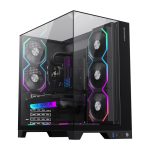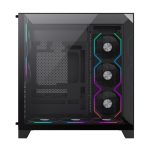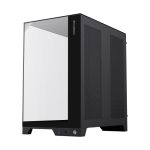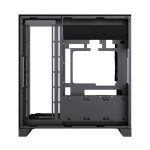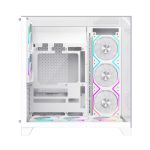GameMax has unveiled its latest dual-chamber PC case series, the Infinity Pro. These new cases have a dual-chamber configuration that enhances airflow and a panoramic tempered glass design that allows users to highlight their internal components in style.
The Infinity Pro case comes equipped with 5x 120 mm PWM ARGB fans (2x FN12A-N2 and 3x FN12A-N2 reverse), ensuring effective cooling performance right out of the box. Additionally, it features a fan and ARGB controller hub, packed with 81 built-in lighting effects that provide various customisation options. When connected to a motherboard's RGB header, you can synchronise all the RGB components attached to the hub, allowing for seamless integration with compatible components.
Designed to be versatile, the GameMax Infinity Pro chassis accommodates back-connector motherboards, including popular models such as Asus BTF, Gigabyte Stealth, and MSI Project Zero. It boasts the capacity to house up to 360 mm radiators, making it an excellent option for liquid cooling enthusiasts. With the ability to support a maximum of 8x 120 mm fans, the Infinity Pro delivers ample cooling potential to keep your gaming rig at optimal temperatures.
The case supports ATX, M-ATX, and ITX motherboards and up to a 3.5-inch hard drive and 3x 2.5-inch SSDs. Moreover, you can mount up to 400-mm-long GPUs, 190-mm-long PSUs, and 160-mm-tall CPU coolers. Lastly, the front I/O features a USB-A 3.0 port, a USB-C port, and a 3.5-mm HD audio jack. The GameMax Infinity Pro is now available for $95.90 in black and white.
Discuss on our Facebook page, HERE.
KitGuru says: The Infinity Pro is quite cheap for a dual-chamber ATX case with fans and three tempered glass panels. However, without knowing the build quality and cooling performance, it can be risky to get one of these, even if the price grabs your attention.
 KitGuru KitGuru.net – Tech News | Hardware News | Hardware Reviews | IOS | Mobile | Gaming | Graphics Cards
KitGuru KitGuru.net – Tech News | Hardware News | Hardware Reviews | IOS | Mobile | Gaming | Graphics Cards


